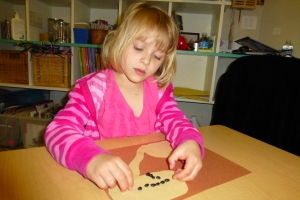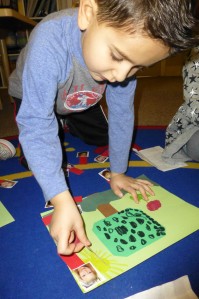 We introduced ten-frames the other day. In Pre-K we begin by using them to tell stories. As you might read in the link above, ten-frames are frequently used when children are beginning to practice subitizing, quickly assigning a verbal number to a set of objects. This is an important mathematical skill, but at this time it is not our main focus. We are focusing on one-to-one correspondence, oral language, turn taking, working memory and basic structure of a ten-frame. Each child approaches the task at their own level, expanding their knowledge and experience.
We introduced ten-frames the other day. In Pre-K we begin by using them to tell stories. As you might read in the link above, ten-frames are frequently used when children are beginning to practice subitizing, quickly assigning a verbal number to a set of objects. This is an important mathematical skill, but at this time it is not our main focus. We are focusing on one-to-one correspondence, oral language, turn taking, working memory and basic structure of a ten-frame. Each child approaches the task at their own level, expanding their knowledge and experience.
The students start with a blank ten-frame. We call it the “garden”. They also have chosen ten glass stones known as dragon tears or dragon seeds. Mrs. Pless or I then tell them a story.
Once upon a time, a wee little [Katie] elf planted three dragon seeds in her garden.
(everyone places three stones in the squares, one for each square starting at the top left)Along came a bird who dropped two more seeds.
(place two more seeds in their plots)The sun shone, the rain came down, the dragon plants grew and grew. Use your fingers to show me how many dragon plants grew in the garden.
The fun begins after they have practiced a few teacher stories. Now it is their turn to tell stories to each other. One narrates while the other reenacts on their garden. Stay tuned for a recent tale…..

 You might have noticed some oddly shaped “art projects” coming home this week. They seem to be shrunken boxing mitts or maybe another attempt at creating our own lungs. However, you are missing the main ingredient. Black beans.
You might have noticed some oddly shaped “art projects” coming home this week. They seem to be shrunken boxing mitts or maybe another attempt at creating our own lungs. However, you are missing the main ingredient. Black beans.



